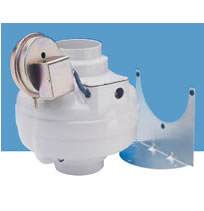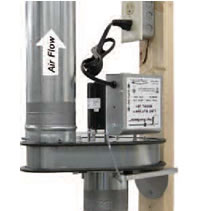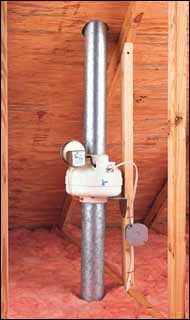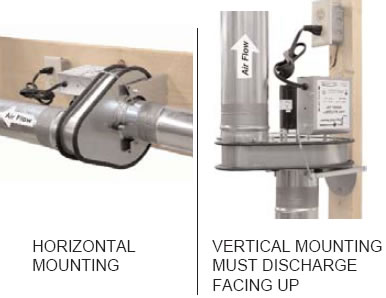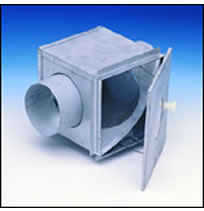|
||||||||||||||||
|
The Solution: The solution is relatively simple for residential dryers: A BOOSTER FAN! Fantech, Tjernlund and S&P all have dryer-booster fans that do just what the name implies. The fans are typically mounted in-line in the existing duct, preferably 15 feet or more from the dryer (more on that later). Each fan has a built-in controller which senses that the dryer is on and allows the dryer-booster fan to run. The Fantech controller cycles the fan at 10 minute intervals until the dryer has stopped and the timer delay has expired. The Tjernlund controller continuously monitors the pressure in the dryer duct and activates the LB when pressure is sensed. These controllers eliminate connections through the dryer circuit which may void the manufacturer's warranty as well as manual systems which require attention of the user or costly current/temperature sensing systems.
If you are very concerned about lint buildup in the fan and maintenance, then have a look at the Tjernlund LB booster. Unlike traditional in-line fans which can clog with lint, the Lint Blitzer impeller is designed to repel lint while providing optimum velocity. It even has a 5 year no clog, no maintenance guarantee! Installation: Installation is easy. Cut the existing duct and attach the booster fan right in-line. The units will require 120 volts AC. No other wiring is required, since all the controls are built in. Some of the fans have power cords (LB and DBF4Xl) and some can be hardwired.
If you must place the dryer-booster fan closer than 15 from the dryer, there is a possibility of wet lint sticking to the fan blades. In this case, we recommend the auxiliary DBLT 4W lint trap (see picture below). This does not apply to the Tjernlund LB. Now for more challenging installations: If your dryer duct is inaccessible, such as under a concrete slab (yes, it happens!), we suggest using an RVF4XL-DB10 combination. This uses the Fantech RVF 4XL wall mounted fan with the DB 10 controller (the same controller used in the DBF 110).
The installation concept is the same, however since the RVF 4XL is mounted outside on the wall, the DB 10 can either be mounted inside, or the installer must provide a weathertight electrical box (rated NEMA 3R) for the DB 10. The same rules for an auxiliary lint trap apply. Some Notes: - use only steel, aluminum or other duct rated for dryer use! - use high quality aluminum duct tape to seal seams and joints that is rated for dryer duct use. - fan installation should be at least 15 feet from the dryer (or add the lint trap). - fan location should allow access for service. Here are some resources to help you with your planning: - Fantech Dryer Boosting Information Page (Fantech Site) - All Dryer Boosting Products As always, if you would like to ask more questions about this or other technical topics give us a call at 877-711-4822 - 9-5 PST. Live people for technical and sales support - an Internet first! More Links: - Fantech DBF 110 Installation Manual - Fantech DBF 4XL Installation Manual - Fantech DB 10 Installation Manual - Tjernlund LB2 Installation Manual Disclaimer: Advice and information given through our representatives is checked for usability and conformance with most codes. You as the user, however, have the responsibility for verifying conformance with local codes and standards and ensuring a safe installation. Although HVACQuick.com may employ and use professionals, their advice is not meant as substitute for professional engineering services. It is the customer's responsibility to hire and retain suitable engineering and architectural professionals as required. |
HVACQuick.com
high performance ventilation & green products - large in-stock inventory!
- team@hvacquick.com
- 888-855-7229
